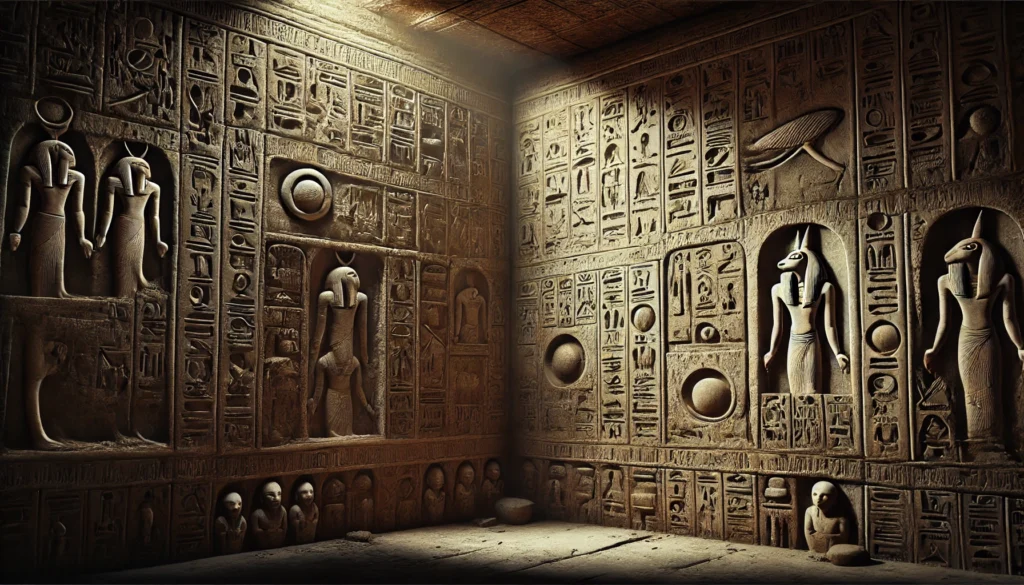The concept of curseology, or the study and application of curses, in ancient Egypt during the Middle Kingdom (roughly 2050–1710 BCE) reflects the Egyptians’ deep beliefs in the power of words, magic, and the unseen forces that could influence both the living and the dead. Here’s an overview of how curses developed and functioned during this period:
1. Religious and Cultural Context
- The Egyptians believed in the power of heka (magic) as a force intrinsic to the universe, controlled by the gods but accessible to humans through ritual and invocation. Curses were one expression of heka, often intended to protect or punish.
- In the Middle Kingdom, Egypt saw a revival in centralized religious practices and heightened attention to funerary rites, leading to more elaborate spells, curses, and protections against grave robbers and desecration.
2. Tomb Curses as a Form of Protection
- Curses were commonly inscribed on tombs to deter robbers and vandals. These inscriptions threatened divine retribution on those who violated the sanctity of the tomb. Typical curses warned of terrible consequences, such as death, illness, or misfortune, to anyone who disturbed the deceased’s eternal rest.
- For example, some tomb inscriptions from this period contain curses that threaten robbers with the wrath of gods like Osiris or Anubis. These gods, associated with death and the afterlife, were believed to be able to exact revenge or bring misfortune.
3. The Power of Words and Symbols
- Egyptians believed that words had an intrinsic power to manifest what they described. Thus, a written curse could activate forces that would harm the perpetrator.
- Curses were carefully worded and often included specific phrases believed to invoke divine action directly. The Egyptians used symbolism, hieroglyphs, and sacred language in these inscriptions, which enhanced the potency of the curse.
4. Notable Examples of Middle Kingdom Curses
- Archaeologists have found several Middle Kingdom tombs with curses. For example, tombs in the Beni Hasan necropolis contain warnings that the deceased will come back to life or the gods will punish the intruder, threatening blindness, infertility, or an early death for those who trespass.
- Inscriptions from the tomb of Senusret III, a powerful Middle Kingdom pharaoh, include protective curses that imply dire consequences for anyone who damages the pharaoh’s resting place, emphasizing divine retribution from Osiris and Ra.
5. Curseology in Daily Life and Magical Practices
- Curses weren’t limited to tombs; they appeared in other contexts, too, such as in spells for protection or retribution. For instance, there were spells for cursing rivals, protection charms inscribed with curses to ward off evil, and objects like clay figurines inscribed with curses, meant to harm enemies.
- Magical texts like the Coffin Texts, which became prominent during the Middle Kingdom, included protective spells and curses that were meant to safeguard the deceased’s journey through the underworld.
6. Ethical and Moral Aspects of Cursing
- Curses were seen as a form of justice, intended to preserve ma’at (cosmic order and balance). To ancient Egyptians, curses served not merely as threats but as necessary safeguards to maintain harmony.
- Only those who violated social norms, such as grave robbers or individuals who wronged others, were seen as legitimate targets of curses. Unjust curses could backfire, so there was a cultural and spiritual restraint in their usage.
7. Influence on Later Curse Practices
- Middle Kingdom curse practices influenced subsequent Egyptian periods, including the New Kingdom and even later Hellenistic traditions. The belief in curses as powerful protective tools continued to be a core element of Egyptian burial practices, evolving and growing in sophistication.
The Middle Kingdom’s use of curses reveals a nuanced understanding of the spiritual and moral landscape in ancient Egypt. Through curses, they sought protection, justice, and continuity in the face of death, displaying their deep-seated beliefs in magic and the afterlife.
